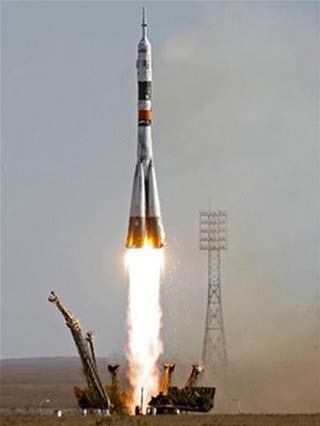Russia is afraid to lag behind in the race to space
The retirement of a series of US spacecraft in the next three years will make Russia a major carrier in bringing the crew up and down the International Space Station (ISS). But there are still many concerns for Russia's travel industry.
According to official statistics, in 2006, Russia was the world leader in the race to space when accounting for 45% of ship launches into space. However, some space experts are expressing concern because the country's space industry can hardly meet the increasing demands in the future.
In 2006, Russia had 24 spacecraft launches, but in 2007 it would have to be reduced to 20 times due to tight budget. The budget for Russia's space program in 2006 was 873 million USD, in 2007 despite higher demand, it could only increase to 912 million USD.
On the morning of April 8, Soyuz left the launch pad at Baikonur Cosmodrome to bring two Russian astronauts and American billionaire Charles Simonyi to ISS for travel and brought in nearly $ 25 million in revenue. However, Soyuz was likened to an old horse that was nearly exhausted in the national space program that existed for 40 years. Currently, Russia produces two Soyuz spacecraft each year and four " Progressive " unmanned cargo ships.
As planned, from 2010, the fleet will increase to 4 Soyuz vessels and 7 ' Progress ' ships. Demand is growing, but government investments for the new spacecraft generation are still very limited.

Soyuz left the launch pad (Photo: TP)
Many Russian experts said that to get more new spacecraft, the government should mobilize financial resources from other projects. In fact, space tourism brought huge revenues for the Russian space industry.
Pavel Vinogradov, who just returned from the ISS in late 2006, warned that if the new generation of spacecraft were not quickly launched, Russia could lag behind the United States, the European Union, China and other countries. other country. The United States ranked second in the world for spacecraft launches (2006) with 18 times, Japan and China ranked third.
"The United States will soon have a new fleet of spacecraft and we will lag behind old ships that no one needs," he said. According to the plan, around 2015 the US will launch the generation of manned Orion spacecraft.
The Russian space industry has been hit hard by a slowing economy after the collapse of the Soviet Union. This industry must not invest in modern equipment, while suffering from the ' bleeding ' of gray matter.
Russia's space program survived primarily through the launch of commercial satellites for foreign countries, the revenue from the transportation of foreign astronauts and space tourism.
The Russian government began investing in the space program when it had oil revenues, but could not meet the huge financial need to replace the Soviet-era spacecraft generation.
The Soyuz and ' Progress ' generation dates from the mid-1960s and are still the pride of the Russians in terms of safety compared to American spacecraft and they just need to renovate the control system. However, Soyuz was only able to bring about 60 kg of cargo back to Earth with the crew, so it was limited to transporting equipment to carry out scientific experiments. The unmanned " Progress " ship can only transport 2.75 tons of cargo to ISS.
Three astronauts on the Soyuz ship had to remain in their seats during the two-day journey from Earth to the ISS and there were other restrictions that reduced the competitiveness of chartering and space travel business.
Total (Summary)
- America's trump card in the space race with Russia
- Russia announced the race to build the Moon space station
- Russia dominates the race in space
- Russia shows off space robots superior to the US and China
- Korolyov - the pride of the Soviet space science
- Shenzhou 10 and the space race
- Easy to 'race' up space
- Russia leads the number of launches to space
- New design warms up the space cruise ship race
- Russia plans to build nuclear spacecraft
- Dubna: Berkeley's worthy rival (2)
- Video: Ship models in the space race between SpaceX and Boeing
 Van Allen's belt and evidence that the Apollo 11 mission to the Moon was myth
Van Allen's belt and evidence that the Apollo 11 mission to the Moon was myth The levels of civilization in the universe (Kardashev scale)
The levels of civilization in the universe (Kardashev scale) Today Mars, the sun and the Earth are aligned
Today Mars, the sun and the Earth are aligned The Amazon owner announced a secret plan to build a space base for thousands of people
The Amazon owner announced a secret plan to build a space base for thousands of people